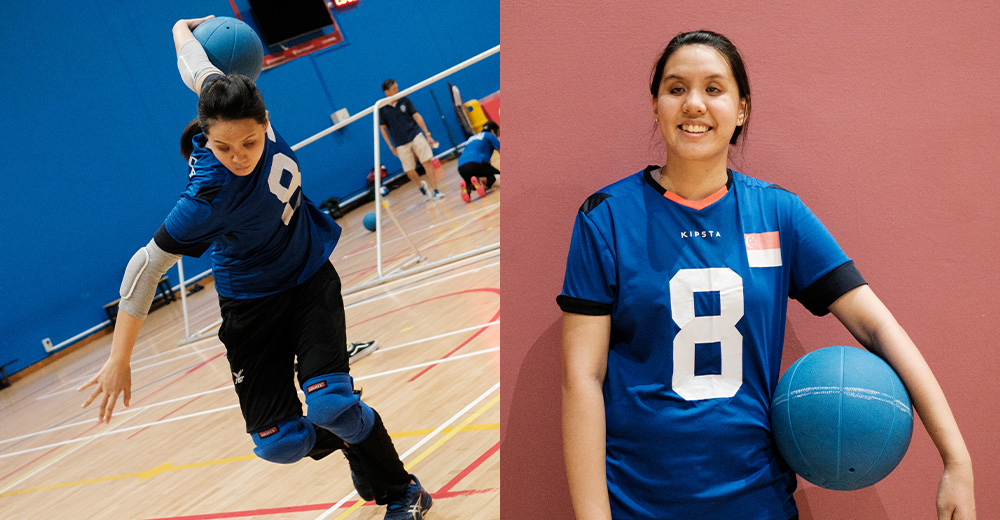Follow us on Telegram for the latest updates: https://t.me/mothershipsg
This article was originally published on Feb. 18, 2023.
This is what it is like to play goalball.
You step up to the field — an indoor pitch 18 by nine metres wide, about two-thirds the size of a basketball court. Goals set up on each side run the width of the playing area, both guarded by three defenders.
You put on your equipment: knee guards, elbow guards. You do warm-ups with the ball, testing its size (roughly that of a basketball) and its weight (1.5kg). You toss it from hand to hand, around your waist, double-checking your grip.
Finally, you take your place beside your teammates. You get down onto the ground, your palms pressed onto the floor and your dominant leg stretched out beside you.
You pull your eye-shades over your face. The world darkens to black.
“Quiet,” the referee barks, and the court falls silent as the sound of her starting whistle rolls across the playing field.
From baskets to goals
The first time I speak to Joan Hung, it’s over Zoom. Her screen is blank. Her camera switched off.
Hung’s was the name I was given when I requested to speak with a local goalball player in hopes of finding out more about the sport. The 27-year-old is one of the team’s most experienced players, a pioneer in her own right, having been instrumental in forming the national goalball chapter.
It’s hard to reconcile that with the woman speaking to me over Zoom. Hung’s manner is amiable; her speech filled with a generous smattering of Singlish — lahs and lors of the fashion that immediately put you at ease.
She starts by telling me about herself. She works at Athlete Development, an organisation that provides coaching and programmes for athletes, as a facilitator. She has a sister who also used to compete, but quit the team to start a family. She’s not a people person by nature, but has gotten better with age and experience.
Her vision loss was inherited — both her parents are fully blind. Like her dad, she has aniridia, which essentially means she has no iris. “Like a spoilt camera lens,” she explains, with the air of having done so a hundred times before.
The way she started playing goalball wasn’t particularly dramatic. During the break between junior college and university, she got a job at Dialogue in the Dark. A few of her colleagues had begun dabbling in the then-unknown sport, which had recently made its debut at the 2015 ASEAN Para Games in Singapore.
When they invited her to come along, Hung agreed.
“I used to like playing —” She corrects herself. “Okay, no, I like playing sports a lot. Like ball games, team sports.”
Back in school, Hung played basketball. Her sight was much better then; it was only in her later teens that she began to lose her vision.
“My friends were kind of nice [when it happened]. They were like, if the ball hits the backboard, it can be considered a point.” She laughs. “But I guess I didn’t feel like I could improve because obviously, hand-eye coordination is everything.”
The learning curve was steep with the new sport. Having been dependent on her vision, limited as it was, Hung struggled to function without it. “Because, like, who ever heard of a sport where you don't need to see before?” she asks rhetorically.
But somewhere along the line — Hung is not quite sure when — goalball started becoming less of a hobby, and more a part of life.
I ask about her typical routine, and if it’s tiring. During the off-season, she trains four to five times a week; during competitions, it’s twice as much. “I usually wake up earlier to maybe go for a run or do a circuit before heading off to work, then after work I just go training lor. I no life one, I just train only,” she quips.
“But I like it lah. I enjoy it.”
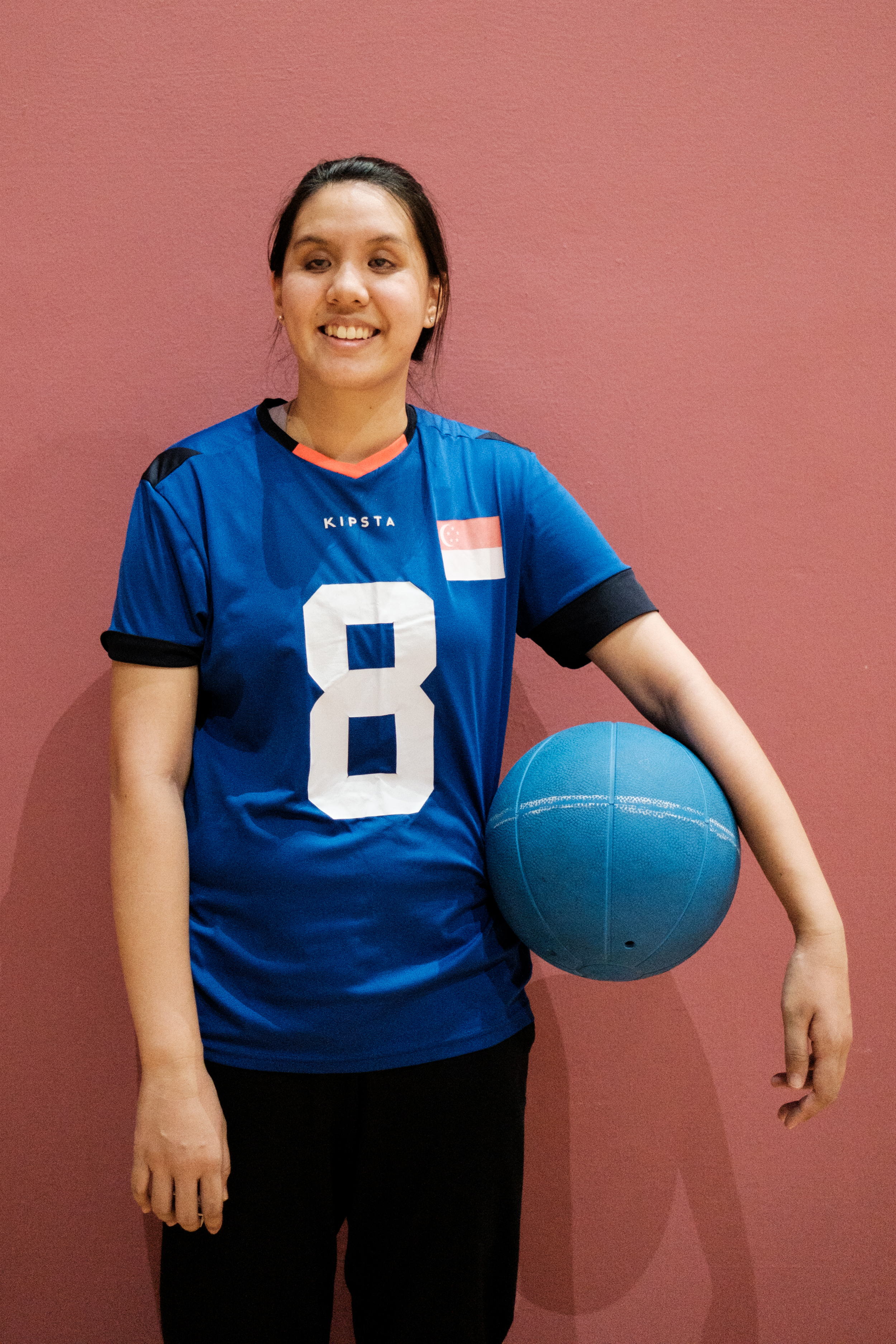 Image by Andrew Koay
Image by Andrew Koay
Designed for the blind
Unlike sports like blind football or wheelchair basketball, goalball has no able-bodied equivalent.
The sport was conceived in 1946 to help rehabilitate veterans who had lost their sight during World War Two. It later evolved into a competitive sport, and finally made its Paralympics debut in 1976. The women’s event was added in 1984.
The rules of goalball are fairly straightforward: the teams each take turns to score and defend. The aim is to successfully roll the ball across the court over their opponent’s goal line. Players use their bodies to block attempted goals, and if successful, they take possession of the ball.
While able-bodied people may dabble in the sport, competitive events require players to be legally blind, meaning they must have less than 10 per cent vision. To ensure fairness, all players must put on eye-shades (which resemble a pair of sports goggles, but with dark, opaque lenses); in competitive play, adhesive eye-patches are applied underneath the shades as well.
This is one of the things Hung likes best about goalball. “Everyone is on a level playing field,” she explains. “It doesn't matter if you're sighted, you have low vision, no vision. Once the eye-shades are on, if you put in the effort, if you put in the time to train…you can improve to the best of your ability.”
“Usually, [learning a sport] like monkey see, monkey do,” Hung tells me. “The coach will show you something, then you just copy.”
But goalball is different. Take the under-arm roll for example, one of their most frequently-used moves. In principle, it is easy to explain the movement. “But when you get to a higher level, with [things like] accuracy — everyone’s body works differently,” she says.
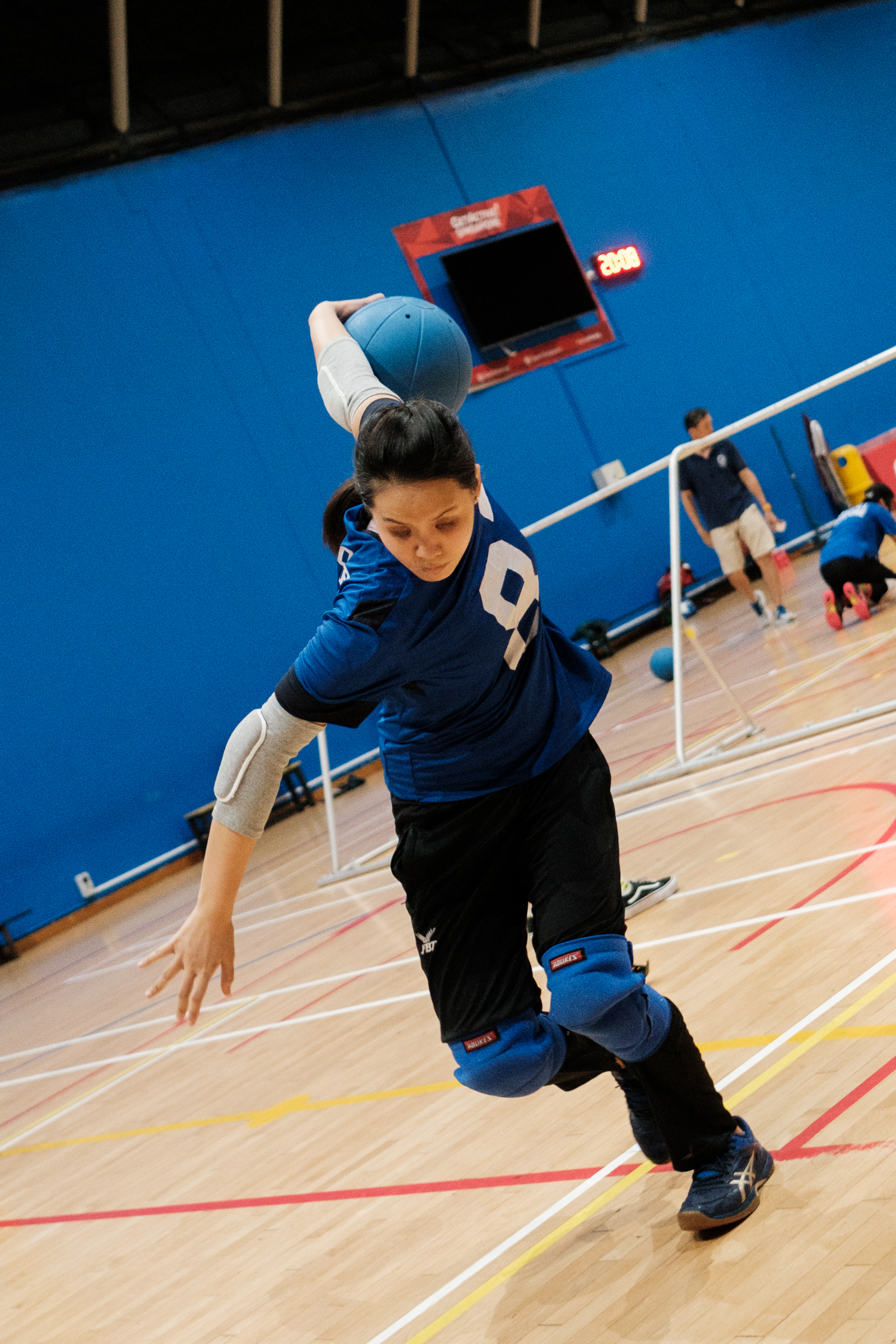 Hung executing a throw. Image by Andrew Koay
Hung executing a throw. Image by Andrew Koay
“And [training] accuracy when you can see, and when you cannot see, is quite different.”
Even for spectators, goalball is unique. The stands are expected to be silent during the game, so the players can hear the ball coming (it has tiny bells inside, which make a faint ringing noise). No-one except the players, not even the coach, is allowed to speak while the game is in play.
“Is the game very dependent on your hearing, then?” I ask.
“And tactile,” Hung responds. “Because when we feel our way around, we are thinking about [things like] where's the best spot to shoot from, or how we communicate with people.”
“So like if you hit somewhere, and then you hear a lot of commotion, for the next ball, you'll probably want to do a quick return. Because they're probably frazzled from that last almost-goal.”
She pauses and considers. “I guess it’s about thinking on your feet lor.”
Goalball for dummies
It’s about a week after our initial Zoom conversation that I finally meet Hung face-to-face.
In person, she cuts an intimidating figure in her blue jersey and no-nonsense French braid. Tall and lean, she looks the picture of what I would get if I keyed into an AI art programme keywords like young, Asian, female, sporty.
When she removes her eye-shades, I notice her clouded irises. It’s a little awkward at first, as I struggle to think of what to say. But she smiles, and it’s not long before we fall into easy conversation, just as we did online.
Today, Hung will be coaching me through a few beginner moves. The team begins to warm up as she guides us to the side of the court. As they toss the ball back and forth, cool as you please, I feel a dawning sense of all-too-familiar inferiority.
It’s like captain’s ball back in secondary school all over again.
To her credit, Hung is a patient coach. First, she shows me how to throw the ball — under-arm, with one hand, crouched low, aimed at the opposing team’s goal.
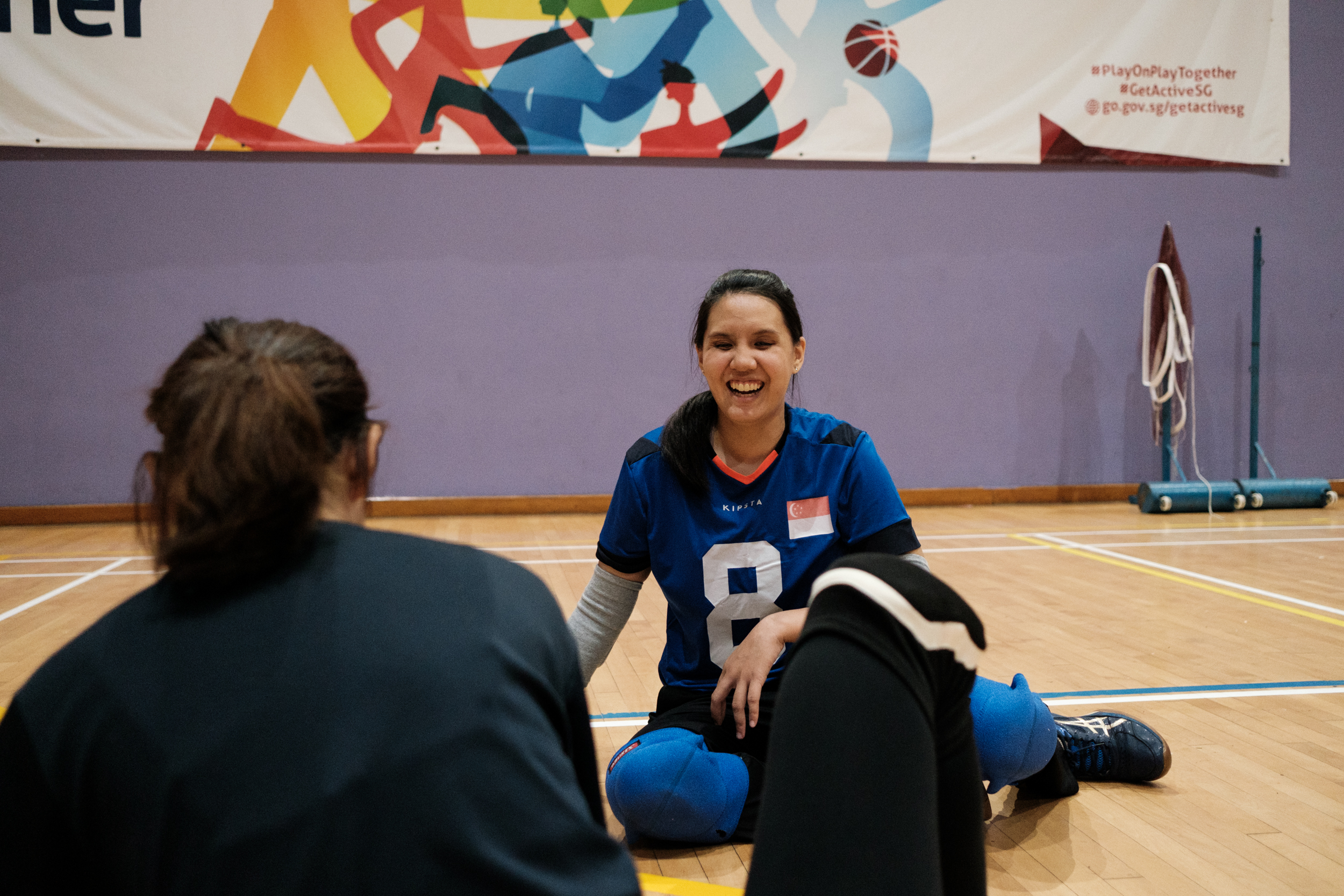 Image by Andrew Koay
Image by Andrew Koay
“Like bowling?” I ask Hung.
“Yeah,” she says brightly. Except the pins are the other players. And they actually want to get hit.
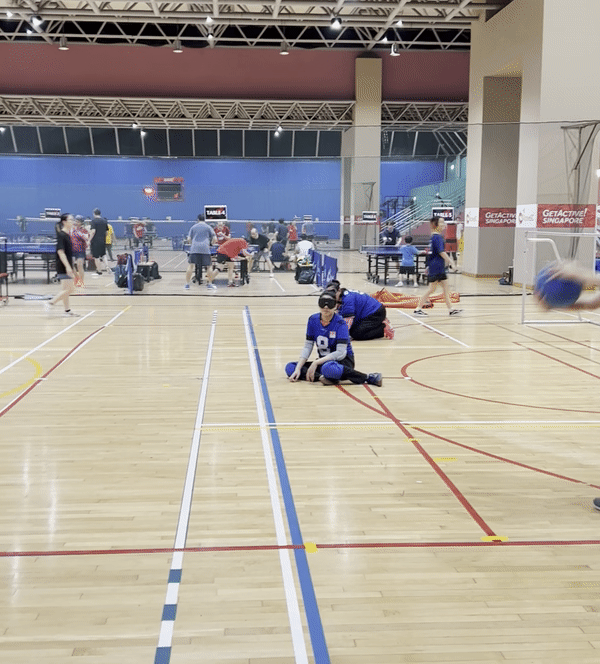
The goalball looks and feels like a fully-blue basketball (only about twice its weight), and I struggle to grip it with just one hand. It probably doesn’t help that my palms are sweating with sheer nervousness.
I muster up the courage to attempt a throw. “Very good!” she tells me encouragingly, even as the ball nudges the wall with a sad-sounding thump.
After a while, Hung switches to defence (perhaps in the vain hope that I’d show more talent there). Blocking, she explains, is done on your hands and knees, hence the need for knee and elbow guards. The most basic of stances involves you lying on your side, propped up by your hands, with your knees bent.
She demonstrates how blocking works: using your hands to push yourself off into either side, you block the incoming ball with your body.
Then, she guides me into position for a few practise throws. The stance I’m in, she informs me, is called the “mermaid pose”.
“Not sure why it's called that," Hung quips. “I think it's more like ‘kopitiam uncle pose’." I laugh appreciatively and try my best not to look like I’m dying.
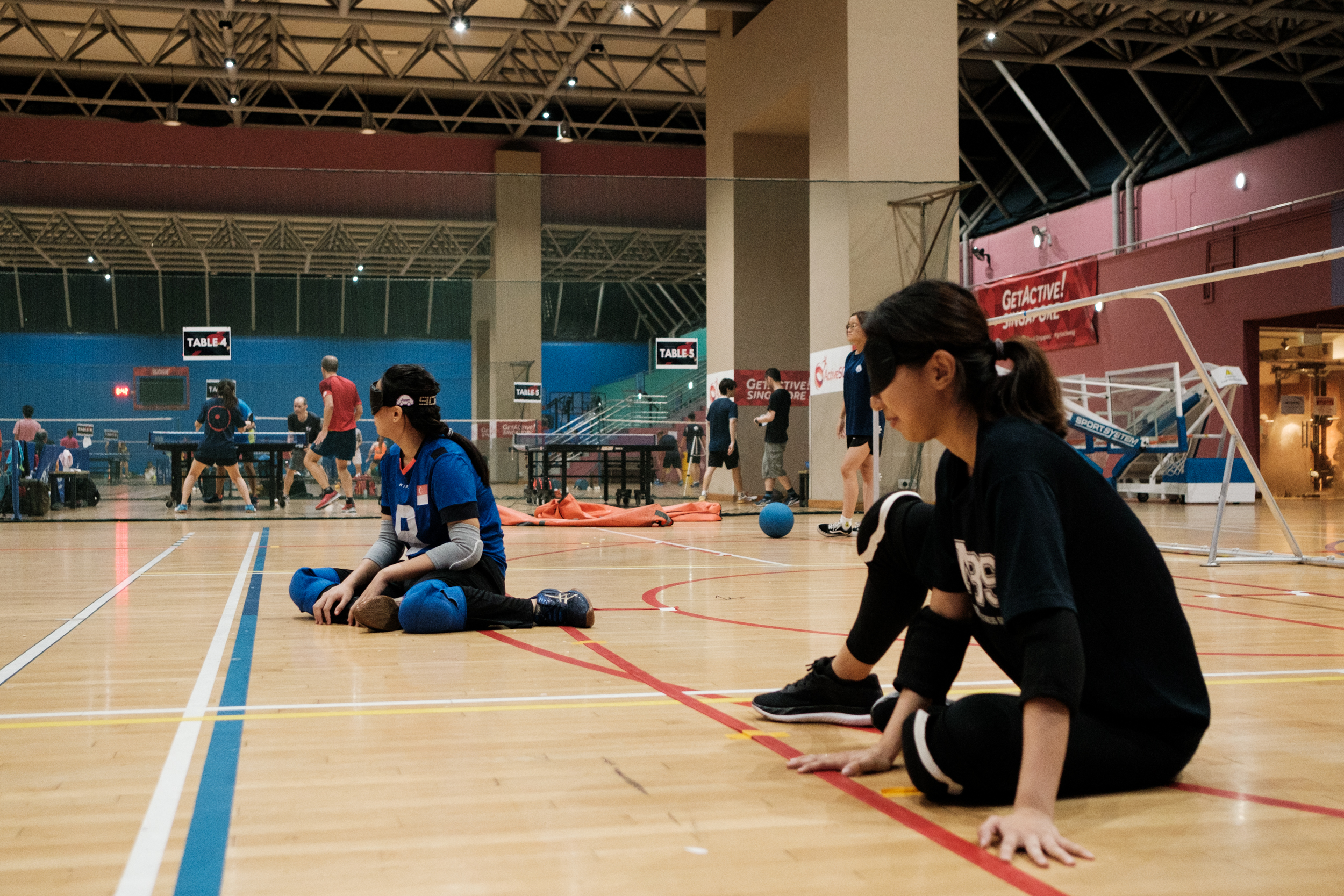 Hung (L) and our writer in the Mermaid or "Kopitiam Uncle" pose. Image by Andrew Koay
Hung (L) and our writer in the Mermaid or "Kopitiam Uncle" pose. Image by Andrew Koay
We do a few more throws. Hung asks if I’d like to try blocking with eye-shades. I demur in favour of more practice.
Just as I’m starting to get comfortable-ish with the ball the coach comes up to me. Gruffly, he informs me that the team is ready for me to sub in.
“What?” I ask.
Playing blindfolded
Standing in the court, my eye-shades pushed up my forehead, I suddenly feel violently out of my depth. Who knew just being in a sports hall could make a person feel 14 years old again?
The whistle blows too quickly, and I scramble into position. Despite the coach’s instructions for the team to go easy on their throws to me, I spend the first few minutes hovering uncertainly at the edge of the court, hoping no one will throw the ball in my direction.
Of course, my colleague — who’d come along with me for the game, and was subbed into the opposing team — saves a goal in the first two minutes. “Eh, he not bad,” my teammate mutters to Hung.
I try not to swell in self-righteous indignation as I heave the ball a few inches too high and am promptly slapped with a penalty.
The minutes pass by in a blur of confusion. I struggle to make sense of the cacophony of noise: the coach’s intermittent whistles, Hung’s sharp raps on the ground. The background noise from the adjoining badminton court doesn’t help.
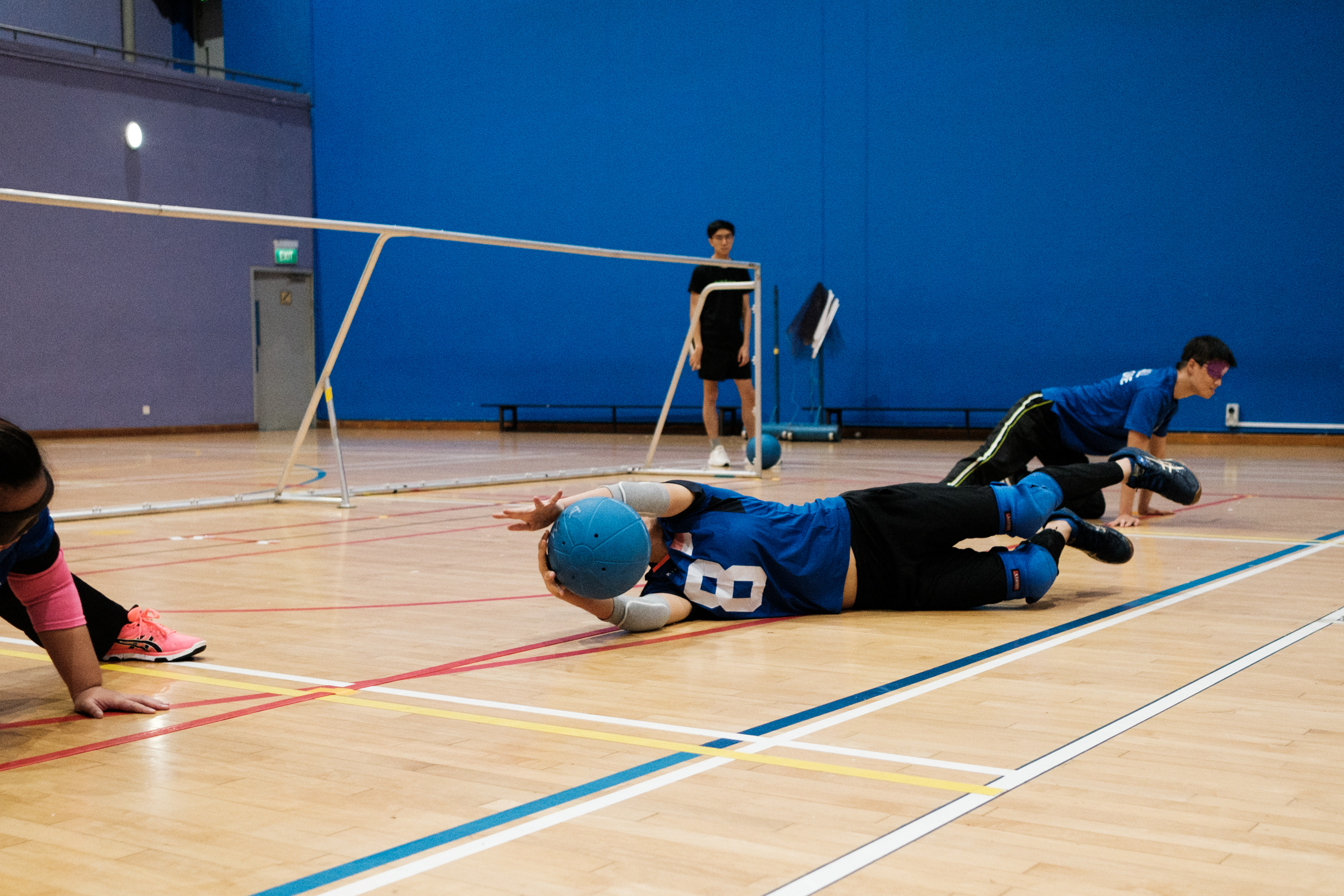 Image by Andrew Koay
Image by Andrew Koay
After my third penalty, the coach signals to me. “Put your eye-shades on,” he hollers. I start to object. He gives me a look.
I put my eye-shades on.
At first, it’s (obviously) terrifying. The eye-shades leave me completely lost as to where I’m facing, or whether I’m two seconds away from taking a ball in the face. “Is this okay?” I ask Hung about 16 times.
It’s a good thing I can’t see her expression.
Gradually, I begin to adjust. The playing area is marked by tactile strips on the floor, which I use to get my bearings. Without the visual stimuli, I’m forced to focus more on the previously-disorienting chorus of sound. I strain to hear the coach’s sharp whistle marking the start of play; the telltale squeak of my opponent’s shoes as they step up and prepare for a throw; and the faint jingling of bells as the ball approaches.
I even manage to swallow my fear of getting hit enough to attempt a couple of blocks.
It’s still scary as hell, and I spend most of the game fiercely missing my eyesight. But at some point, something clicks and I realise I’m actually kind of enjoying it.
My turn comes to throw. Someone tosses me the ball (I manage to find it after some scrambling around on the ground). Blindly, I feel for the goalpost, and hope desperately that I’m facing the right direction.
“Is this okay?” I ask for the 17th time.
I throw.
A few seconds pass. The coach whistles, and the hall explodes into commotion. “Very good!” Hung calls, but there’s a laugh in her voice this time.
My throw had been weak — but just weak enough to silently roll past the players, through a gap in the defensive line (an actual tactic, I’m informed later). I’d scored my first goal.
Facing their fears
Despite being a relatively young team, Hung and her teammates have experienced their fair share of milestones.
They were the first women’s team in Singapore to get carded for disability sports. While still in its infancy, the team won the Malaysian nationals in 2017, and later emerged from the 2022 ASEAN Para Games — their first — with a silver medal.
But it’s not clear what lies ahead. Like many other sports in the local scene, goalball suffers from a dearth of manpower.
The team currently operates on a skeleton crew. During competitions, it’s an all-hands-on-deck situation; for the upcoming ASEAN Para Games in Cambodia, there probably won’t be enough players to form a full team.
“It’s hard finding players for goalball…We just don't have enough people,” Hung admits. Awareness is limited; many people think goalball is only for the fully-blind. To make matters worse, many people with disabilities don’t play sports — and those who do, may not be able to translate their athleticism into playing a sport completely blind.
Over her nine years on the team, Hung has seen people — particularly those with degenerative conditions — struggle to assimilate. Many are still coming to grips with their impairment, never mind applying it functionally to a sport.
“And in a way, putting on eye shades is kind of like, facing one of their biggest fears,” Hung says. “Because that’s basically what may happen to them.”
It’s a fear that Hung can empathise with. Her vision loss began in junior college, but recently, it’s been getting worse. She can still see — her current vision is kind of like having “really, really bad myopia” — but she doesn’t know how much further her sight will deteriorate.
At one point, she wasn’t sure if goalball would end up becoming a victim of her disability, too. “It was like, oh my god, am I gonna like…” She trails off, not wanting to say it. “Like, if I can't function, or if I had to learn to function outside of the sport, and if it’s difficult enough…I wasn't sure whether I still could play and put so much time into training.”
Fortunately, she’s doing better now, largely thanks to her coach — Bay Hansen. “His real rice bowl is more like, mental skills and sport psychology,” Hung shares.
“So he taught us to focus on what we could do lah. Like, growth mindset and locus of control, that kind of thing…so instead of just harping on about your issues, think about what you want to do differently.”
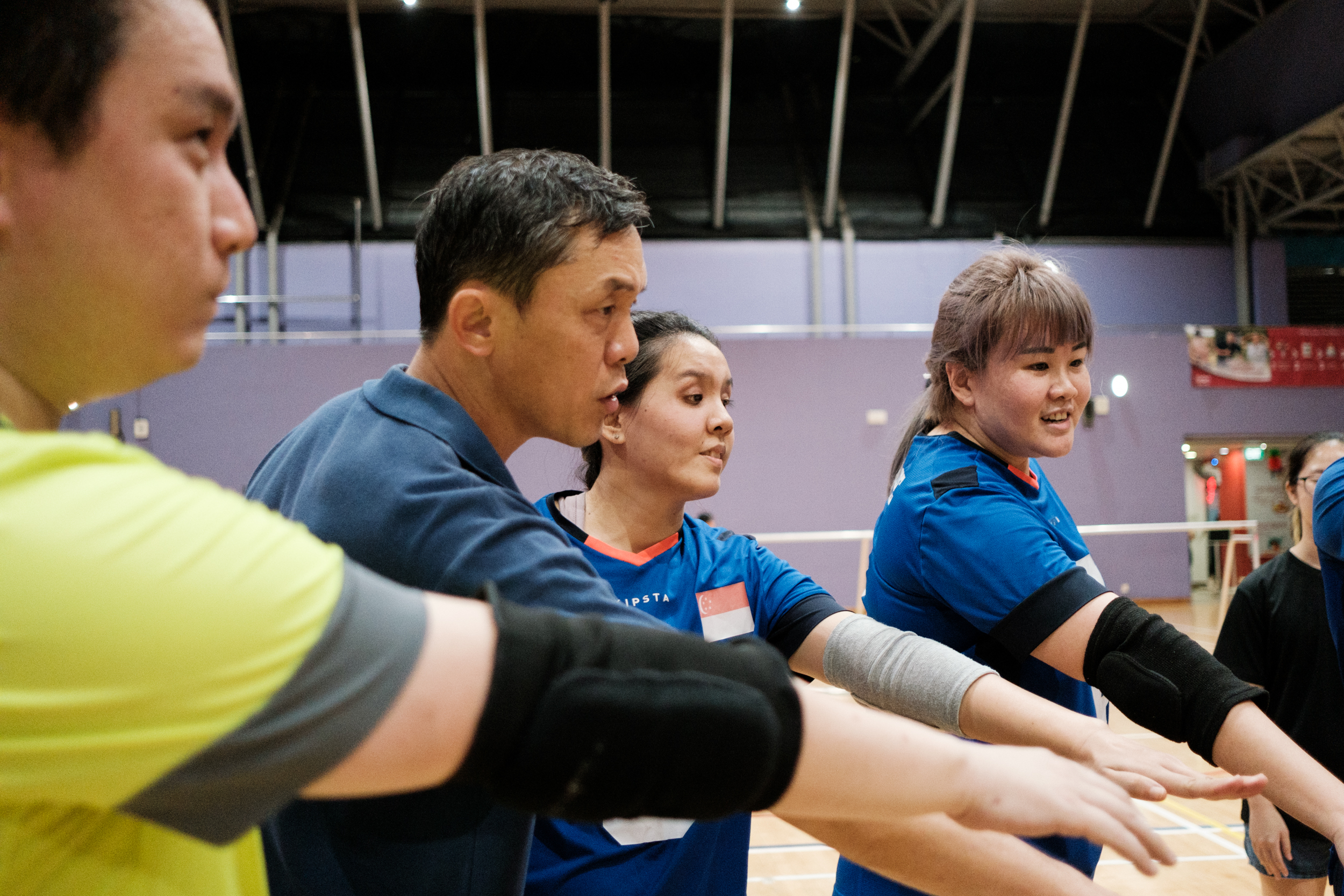 Image by Andrew Koay
Image by Andrew Koay
Rooting for the anti-hero
Finally — possibly sensing my exhaustion — Coach Hansen tells me that I can sub out of the game if I like. I push my eye-shades up and immediately wince at the suddenly-glaring lights of the sports hall.
I’m still in somewhat of a daze as I find a seat at the side of the hall to settle down and watch. It’s not hard to find Hung, though — even in a practise match, she stands out easily.
Caught in the electricity of the game, she is all focus, all tension. She moves with confidence and conviction, with none of the mild affability I saw earlier. When she controls the ball, it’s with the kind of ease that you only ever see with professional athletes on TV. Like it’s an additional appendage, as natural as an arm or leg.
I realise that I had expected Hung to be different. I’d wanted her to be a poster child for para-athletes. But Hung isn’t really; she has no tragedy, no devastation in her story. Blindness, to her, was written in her DNA. Less misfortune than mere inevitability.
Even the uncertainty she faces — both in the sport, and in her own vision — is not unique. Athletes are all counting down to the day their time runs out, either by age or by injury. Hung is no different.
It strikes me that to Hung, goalball may also play the role of a simple coping mechanism. Perhaps this is the way she contends with the terrifying prospect of total sightlessness: by forcing her way into it, head-first, armed with a ball and sheer willpower. After all, she has never set out to be a pioneer. She has never wanted to do anything more than play a ball game and kick ass.
Que sera, sera
Towards the end of our conversation, I ask her if she’s ever considered quitting.
“Not seriously,” she says.
“There have been times when I wasn't in the brain space to train, but it has not been a conscious thought like, ‘Okay, I don't think I want to play this anymore.’ It’s more like a byproduct, if something happens, or if it’s time to focus on something else.”
As for her future: she’d like to keep playing, but doesn’t know what’s going to happen. “I mean, whether the sport can survive is not certain.” This parallel with her sight passes between us, unspoken.
For now, Hung has begun to coach the sport. “So that's something that is really interesting,” she tells me, “because I coach both able-bodied kids in mainstream schools to share more about the game, as well as blind kids.”
Watching the next generation, Hung says, also means watching how the sport changes and grows. She may not know what the future holds, but she does have a front-row seat.
“So I may continue the sport, maybe. But not in the same role.” Matter-of-fact. Unsentimental. Unheroic, and yet, in a strange way, brave.
After all, as with most things in life — sometimes you just need to go in blind.
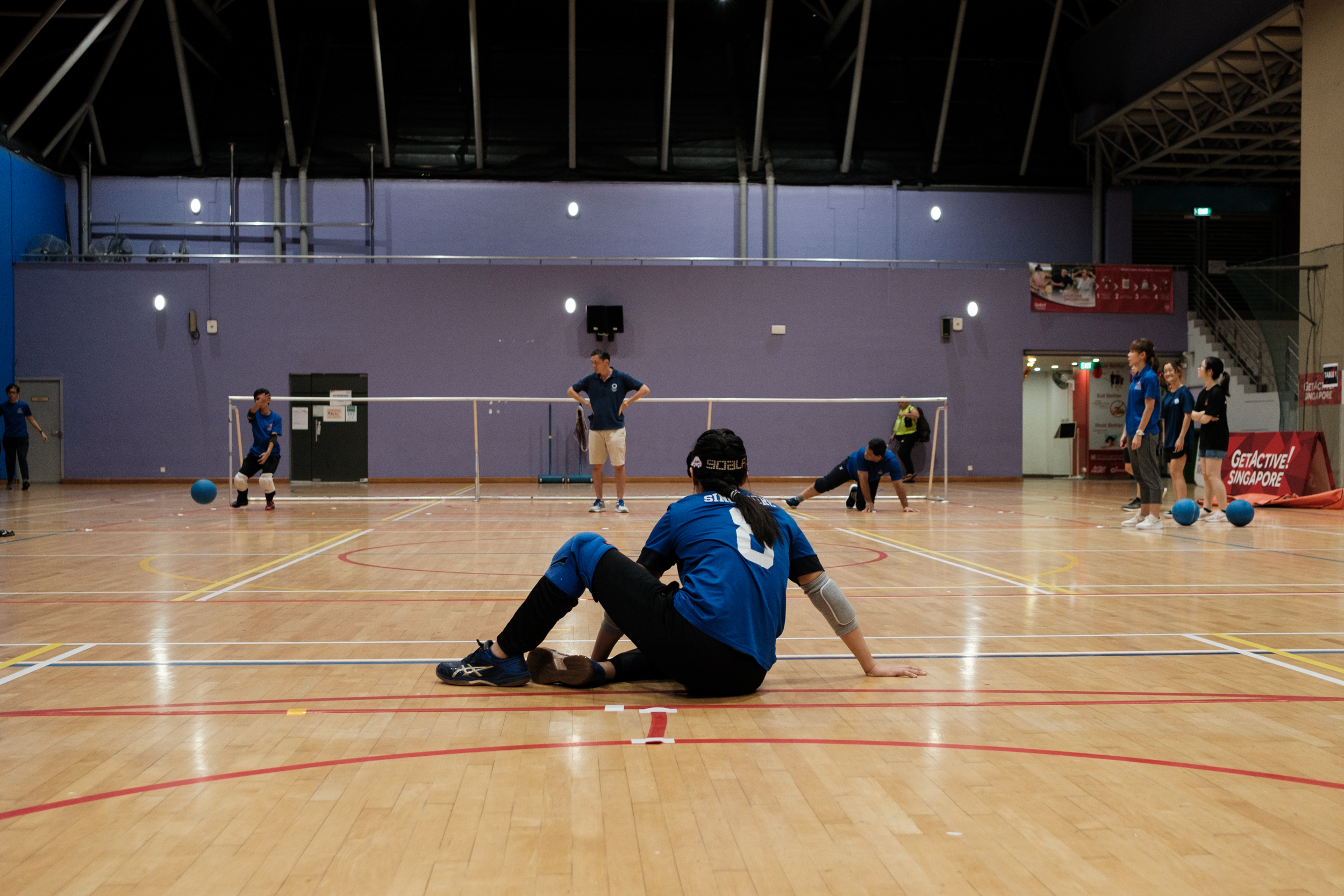 Image by Andrew Koay
Image by Andrew Koay
If you like what you read, follow us on Facebook, Instagram, Twitter and Telegram to get the latest updates.
